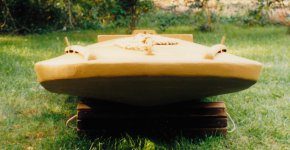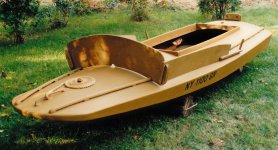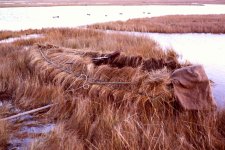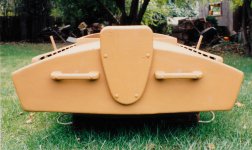Good morning, All~
Although Jersey will always be the capital of garveys - of all sizes and uses - we Long Islanders have long used the hull form for work and play. I never saw anyone jumping mud flats - but I have poled mine garvey-inspired gunning vessel across wet mud. Aside from Mr. Guenther somehow holding onto/staying within the boat during his mudflat leaps, I do wonder about the outboard. I'm pretty sure there were no longtail motors back in his day. And, I can tell you that navigating Long Island's gunning grounds entails lots of motoring across shoals. My 9.9 Johnson was never locked in the DOWN position - and popped up unexpectedly many when in unfamiliar waters on moon low tides...
Lots of duckboats were built garvey-style. Although, I must say I have not seen one in years and have no photos. of others' gunning garveys. Generally, their bows were a bit wider than Guenther's boat.
I designed my first gunning boat along the lines of a garvey (the first boat I owned was a 16-foot garvey for clamming) but gave it a bit of deadrise and a rounded nose. She was framed in Oak and Mahogany and sheathed with 1/4-inch marine plywood.
View attachment 58229
If I built this boat again, the fore and aft coamings would be crowned to follow the decks. The pipe oarlock stanchions were a common feature on Long Island gunning boats of all kinds.
View attachment 58228
Like a Sneakbox, I put a less-than 6-foot-long cockpit on the boat - and lay facing forward to hunt. I first made a stool rack for the stern - like a Sneakbox - but abandoned it when the outboard tiller threatened the heads of my decoys. Moving it to the foredeck protected the decoys and also gave some protection from errant seas. The 3 pieces - which had no hardware - were stowed below decks whilst hiding.
View attachment 58230
I never got around to sewing a spray shield before I sold it - to make way for the 2-man successor i built. It was a fine 1-man boat and I wonder where she might be nowadays.
View attachment 58231
If I still lived on Long Island, I would build myself a 16-or-17-foot open garvey - just for getting around.
All the best,
SJS






